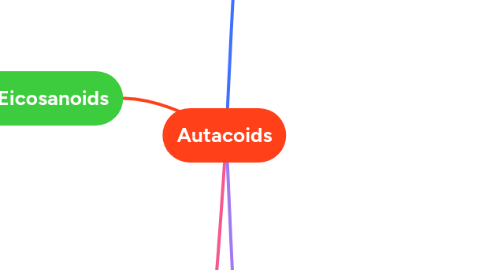
1. Prostaglandins and Eicosanoids
1.1. Eicosanoids
1.1.1. Eicosanoid Antagonists
1.1.1.1. Corticosteroids
1.1.1.1.1. o Inhibits PLA2 o Prevents formation of Arachidonic Acid
1.1.1.2. NSAIDS
1.1.1.2.1. o Inhibits COX o used as antiplatelets (TXA2 inh.) - Aspirin o Prevents formation of PG, PGI and TXA2
1.1.1.3. Leukotriene Antagonists
1.1.1.3.1. Zileuton, Montelukast, Zafirlukasts
1.1.2. Sites Affected of Eicosanoids a. Vascular Smooth Muscles b. Bronchial Smooth Muscles c. Platelet d. Cytoprotection (Stomach mucus production) e. Uterus - Uterine Contraction f. Eyes – Intraocular Pressure
1.2. Prostaglandins
1.2.1. DRUGS & ANALOGUES
1.2.1.1. a. Alprostadil b. Misoprostol c. Epoprostenol d. Dinoprostone e. Carboprost and Latanoprost
1.2.1.1.1. Alprostadil ⚫PGE1 analogue ⚫Effect: Vasodilator ⚫Use: Erectile dysfunction (Urethral suppository)
1.2.1.1.2. Misoprostol ⚫PGE1 analogue ⚫Effect: Cytoprotection ⚫Use: Alternative treatment for NSAID induced gastritis
1.2.1.1.3. Epoprostenol ⚫Prostacycline (PGI2) analogue ⚫Effect: Vasodilator ⚫Use: Symptomatic management of primary pulmonary Hypertension
1.2.1.1.4. Dinoprostone ⚫PGE2 analogue ⚫Effect: Uterine Contraction ⚫Use: Abortifacient (Promotes uterine contraction)
1.2.1.1.5. Carboprost & Latanoprost ⚫PGF2alpha analogue ⚫Effect: Decreases Intraocular Pressure ⚫Use: Treatment for Glaucoma
2. Vasoactive Peptides
3. Histamine receptor blockers and agonists
3.1. H1 Blocker
3.1.1. 1st Gen (Sedating)
3.1.1.1. ▪ Ethanolamine ▪ Ethylenediamine ▪ Piperazines ▪ Alkylamine ▪ Phenothiazine ▪ Piperidine
3.1.1.1.1. ETHANOLAMINES
3.1.1.1.2. ETHYLENEDIAMINES
3.1.1.1.3. PIPERAZINES
3.1.1.1.4. Alkylamines
3.1.1.1.5. Phenothiazine
3.1.1.1.6. Piperidine
3.1.2. Less Sedating 1st Gen
3.1.2.1. Piperazines
3.1.2.1.1. ✔ Cetirizine ( Virlix, Alnix) ✔Levocetirizine ( Xyzal)
3.1.3. 2nd Generation (Non-Sedating)
3.1.3.1. ⚫Piperidine
3.1.3.1.1. ✔ Desloratidine (Aerius) ✔ Astemizole ✔ Loratidine (Claritin) ✔ Fexofenadine
3.1.4. Toxicity With H1-Blockers
3.1.4.1. ⚫Sedation – 1st generation H1- blockers ⚫Arrhythmia – Promethazine and Astemizole ⚫Dry mouth and Blurred vision – those with antimuscarinic effects ⚫Orthostatic hypotension – Promethazine (has action on alpha receptors)
3.2. H2 Blocker
3.2.1. ⮚Ranitidine (Zantac) ⮚Cimetidine (Tagamet) ⮚Famotidine (Pepcid) ⮚Nizatidine (Axid) – 100% bioavailability
3.2.1.1. ⚫Use: Alternatives for management of Acid peptic diseases and GERD (Take at bedtime)
3.2.1.2. ⚫Side effects: Cimetidine– enzyme inhibitor; anti- androgenic (male:Gynecosmastia; Female: Infertility and loss of libido)
3.3. Agonists
3.3.1. Histamine Agonist
3.3.1.1. ✔ Obsolete ✔ Diagnostic agent ✔ Pulmonary Challenge Test ✔ Quantifies or determine gastric acid secretion (Work-up for Achlorhydria)- HCL Absence in body
3.3.2. Betahistine (Serc) Agonist
3.3.2.1. ✔ Partial H1 agonist ✔ Centrally-acting ✔ Anti-Vertigo
3.3.2.2. H3 ANTAGONIST
4. Serotonin receptor
4.1. 5HT1A
4.1.1. ⚫Partial agonist in the brain ⚫Use: Anxiolytic
4.1.1.1. Buspirone
4.1.2. ⚫Location: CNS in Presynapse of neurons ⚫Effect: Decreases release of Serotonin
4.2. 5HT1B/1D
4.2.1. ⚫Agonists: ⚫Sumatriptan (Least PO Bioavailability) – Most ADRs ⚫Naratriptan (Most PO Bioavailability) ⚫Zolmitriptan
4.2.1.1. ⚫Sumatriptan is the prototype and may be given PO, SQ and Inhalational ⚫Duration of action: 2-3 hrs except for naratriptan (~6hrs)
4.2.1.2. ⚫Metabolism: By MAOA except for naratriptan (CYP) ⚫Uses: Acute migraine and Cluster Headache ⚫Side Effects: Coronary Vasospasm; Paresthesias; Hypertension; QT prolongation (arrhythmia)
4.2.2. ⚫Gi coupled ⚫Location: Peripheral Smooth Muscles ⚫Effect: Contraction
4.3. 5HT2A
4.3.1. Partial Agonist: Ergotamine, Dihydroergotamine (DHE)
4.3.1.1. Route: ✔Ergotamine: PO, SL and Rectal(best route) ✔DHE: PO, SQ, IM, IV
4.3.1.1.1. ⚫USES: Management of Acute migraine and Cluster Headache
4.3.1.1.2. Ergotamine + Caffeine = Synergism
4.3.1.1.3. Ergots should be limited to Not more than 2 weeks of dosing due to risk of rebound headache • Adverse effects: oErgotism(St. Anthony’s Fire): N&V; Paresthesia; Vasospasms (inc. BP) oRetroperitoneal fibrosis(scarring at peritoneum)
4.3.2. ⚫Gq-Coupled ⚫Location: Smooth Muscle ⚫Effect: Vasoconstriction
4.4. 5HT2C
4.4.1. Agonist: ✔ Lorcaserin ✔Fenfluramine ✔Dexfenfluramine
4.4.1.1. USE: Reduces appetite for weight control * Dexfenfluramine was combined with Phentermine – “dex-phen” = anorexic (Banned)
4.4.2. ⚫Location: CNS ⚫Effect: Reduces appetite
4.5. 5HT3
4.5.1. Antagonists: ✔Ondansetron (Zofran) ✔Granisetron (Kytril) ✔Tropisetron ✔Palonosetron (Aloxi) ✔Ramosetron (Nasea)
4.5.1.1. USE: Management of CINV(Chemotherapeutic Induced Nausea and Vomiting)
4.5.1.2. Route: ✔PO, IV, TD (Granisetron for 7 days) ✔Palonosetron (Given as single IV dose for 5-7 days)
4.5.2. ⚫Ligand gated ion channel ⚫Location: Area of postrema of CTZ (Chemoreceptortrigger zone) ⚫Effect: Vomiting
4.6. 5HT4
4.6.1. Agonist: ✔Tegaserod ✔Cisapride (Obsolete)
4.6.1.1. USE: Management of Irritable Bowel syndrome and GERD(w/o gastric acid alteration)
4.6.2. ⚫Gs- Coupled ⚫Location: GIT ⚫Effect: Peristalsis
